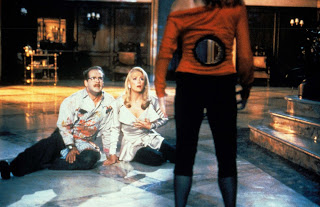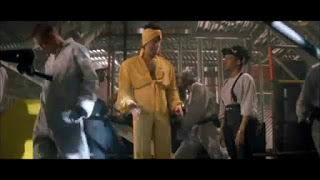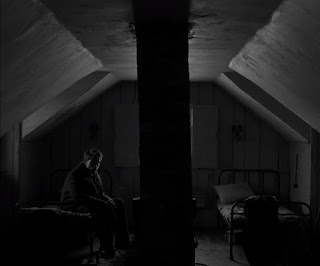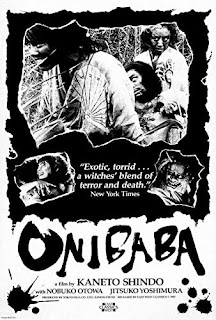Happy Halloween! The countdown is over and Halloween is finally upon us. Tonight, hopefully, you'll be relaxing, eating some candy, and watching a scary, or not-so-scary, movie. There are a lot of options for tonight and I hope I've been of some help. Here is my final recommendation to help bring an end to Shocktober:
Night 13: Happy Happy Halloween
“'Til death do us part! Well, you girls are dead. And I'm parting.”
Death Becomes Her
Night 13: Happy Happy Halloween
“'Til death do us part! Well, you girls are dead. And I'm parting.”
Death Becomes Her
You’ll find few horror comedies as absolutely fun and satisfying as Death Becomes Her. This is due in no small part to the stellar performances from Meryl Streep, Goldie Hawn, Bruce Willis, and Isabella Rossalini and the filmmaking wizardry of Robert Zemeckis. As with the Back to the Future movies and Who Framed Roger Rabbit?, Zemckis mixed cutting edge visual effects with a fun story and lively characters to create a wonderful, delightful movie.
Death Becomes Her opens on a fabulous note; actually, several notes. The year is 1978 and we see fading theater star Madeline Aston (Meryl Streep) in her new play, Songbird, a disco musical of Sweet Bird of Youth. Streep is dressed in a sparkling gown and boa and surrounded by male dancers. The audience is either walking out or bored and falling asleep except for Dr. Ernest Menville (Bruce Willis), much to the chagrin of his fiancé Helen Sharp (Goldie Hawn). The dowdy Helen and glamourous Madeline are supposed to be friends, though frenemies would be a polite way to explain their relationship. Sure enough, Madeline steals away Ernest and Helen goes in a downward spiral that includes some pretty funny scenes of her gaining a ridiculous amount of weight, being evicted from her apartment, and being put into an institution. Then, she comes up with a plan for revenge.
Years pass and image conscious Madeline can no longer hide the effects of aging. She is introduced to the beautiful and mysterious Lisle Von Rhuman (Isabella Rossellini), who provides Madeline with an elixir that will give her what she wants most: eternal youth. She also gives Madeline a stern warning, after Madeline has already drunk the elixir, to take care of her body. Madeline is indeed rejuvenated but doesn’t have much time to enjoy it since she finds out that Ernest and Helen, now thin and glamourous, are plotting to kill her and run away together. It turns out that Madeline can’t be killed, but her body can be broken and still, mostly, work. So, when she falls down the stairs and twists her head totally around, she’s still alive and feels, mostly, fine. When Madeline blasts a hole through Helen’s stomach with a shotgun, Helen is also still alive and, mostly, fine. They continue to inflict damage on each other while Ernest, shocked and confused, is caught in the middle.
The effects may have a slightly dated look now, but were remarkable for 1992. Frankly, even with the dated look, the visual effects are still impressive. It’s no surprise to learn that Death Becomes Her earned an Academy Award for its visual effects. Watching Madeline’s head spin around after Helen hits her with a shovel or water spill out of a hole in Helen’s stomach is so much fun. It’s like watching a live action Looney Tunes cartoon. As their bodies become more and more broken and they hobble around after each other, the humor goes over the top and absurd in the best way possible. It is obvious that Zemeckis loves using visual effects, computer created or practical, whenever possible. His willingness to experiment with visual effects would be to his detriment later in his career, but unlike in his later films, the effects in Death Becomes Her enhance the story instead of overtaking it.
As important as the impressive visual effects are to the macabre plot, Death Becomes Her would be nowhere near as fun or good without its killer stars: Meryl Streep and Goldie Hawn. Both actresses play their parts with total glee. They go from zero to camp and back again at all the right moments. No matter who is mutilating who, thanks to their natural charisma they are both enjoyable characters. There’s no argument that Meryl Streep is one of the best actresses, ever, but she is so lauded for her dramatic work, that it’s easy to forget just how good she is at being funny. After the wonderful misfire of the opening song and dance number, we get a quick moment of her in her dressing room rehearsing different greetings for Helen. It’s a small moment but brilliant comic acting. Goldie Hawn plays both the dowdy frizzy-haired Helen and the elegant, fabulous Helen with equal ease. It’s easy to forget that before Bruce Willis became an action star, and then a self-serious action star, he started in comedy (Moonlighting), and is really good at it. He’s fantastic as the meek and high-strung Ernest. Willis acts as an audience stand in, having the appropriate freak out reactions to everything happening on screen. Isabella Rossellini is perfectly cast as the mysterious and alluring Lisle. She wears an elaborate necklace as a top and has silent muscle-bound man servants in spandex do her bidding. Everything about her character and her performance is everything you never knew you wanted to see.
Death Becomes Her plays like a classy but still campy episode of Tales From the Crypt, which Robert Zemeckis directed three episodes of and executive produced. Despite all of the damage Madeline and Helen inflict on each other’s bodies, there’s no graphic or explicit violence, so this movie could be easily enjoyed by anyone looking for something fun to watch this Halloween. “Easily enjoyed” are the key words. Just sit back and have a Happy Halloween!
Death Becomes Her opens on a fabulous note; actually, several notes. The year is 1978 and we see fading theater star Madeline Aston (Meryl Streep) in her new play, Songbird, a disco musical of Sweet Bird of Youth. Streep is dressed in a sparkling gown and boa and surrounded by male dancers. The audience is either walking out or bored and falling asleep except for Dr. Ernest Menville (Bruce Willis), much to the chagrin of his fiancé Helen Sharp (Goldie Hawn). The dowdy Helen and glamourous Madeline are supposed to be friends, though frenemies would be a polite way to explain their relationship. Sure enough, Madeline steals away Ernest and Helen goes in a downward spiral that includes some pretty funny scenes of her gaining a ridiculous amount of weight, being evicted from her apartment, and being put into an institution. Then, she comes up with a plan for revenge.
Years pass and image conscious Madeline can no longer hide the effects of aging. She is introduced to the beautiful and mysterious Lisle Von Rhuman (Isabella Rossellini), who provides Madeline with an elixir that will give her what she wants most: eternal youth. She also gives Madeline a stern warning, after Madeline has already drunk the elixir, to take care of her body. Madeline is indeed rejuvenated but doesn’t have much time to enjoy it since she finds out that Ernest and Helen, now thin and glamourous, are plotting to kill her and run away together. It turns out that Madeline can’t be killed, but her body can be broken and still, mostly, work. So, when she falls down the stairs and twists her head totally around, she’s still alive and feels, mostly, fine. When Madeline blasts a hole through Helen’s stomach with a shotgun, Helen is also still alive and, mostly, fine. They continue to inflict damage on each other while Ernest, shocked and confused, is caught in the middle.
The effects may have a slightly dated look now, but were remarkable for 1992. Frankly, even with the dated look, the visual effects are still impressive. It’s no surprise to learn that Death Becomes Her earned an Academy Award for its visual effects. Watching Madeline’s head spin around after Helen hits her with a shovel or water spill out of a hole in Helen’s stomach is so much fun. It’s like watching a live action Looney Tunes cartoon. As their bodies become more and more broken and they hobble around after each other, the humor goes over the top and absurd in the best way possible. It is obvious that Zemeckis loves using visual effects, computer created or practical, whenever possible. His willingness to experiment with visual effects would be to his detriment later in his career, but unlike in his later films, the effects in Death Becomes Her enhance the story instead of overtaking it.
As important as the impressive visual effects are to the macabre plot, Death Becomes Her would be nowhere near as fun or good without its killer stars: Meryl Streep and Goldie Hawn. Both actresses play their parts with total glee. They go from zero to camp and back again at all the right moments. No matter who is mutilating who, thanks to their natural charisma they are both enjoyable characters. There’s no argument that Meryl Streep is one of the best actresses, ever, but she is so lauded for her dramatic work, that it’s easy to forget just how good she is at being funny. After the wonderful misfire of the opening song and dance number, we get a quick moment of her in her dressing room rehearsing different greetings for Helen. It’s a small moment but brilliant comic acting. Goldie Hawn plays both the dowdy frizzy-haired Helen and the elegant, fabulous Helen with equal ease. It’s easy to forget that before Bruce Willis became an action star, and then a self-serious action star, he started in comedy (Moonlighting), and is really good at it. He’s fantastic as the meek and high-strung Ernest. Willis acts as an audience stand in, having the appropriate freak out reactions to everything happening on screen. Isabella Rossellini is perfectly cast as the mysterious and alluring Lisle. She wears an elaborate necklace as a top and has silent muscle-bound man servants in spandex do her bidding. Everything about her character and her performance is everything you never knew you wanted to see.
Death Becomes Her plays like a classy but still campy episode of Tales From the Crypt, which Robert Zemeckis directed three episodes of and executive produced. Despite all of the damage Madeline and Helen inflict on each other’s bodies, there’s no graphic or explicit violence, so this movie could be easily enjoyed by anyone looking for something fun to watch this Halloween. “Easily enjoyed” are the key words. Just sit back and have a Happy Halloween!




















































